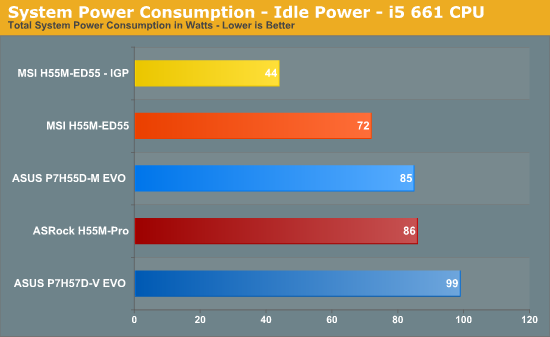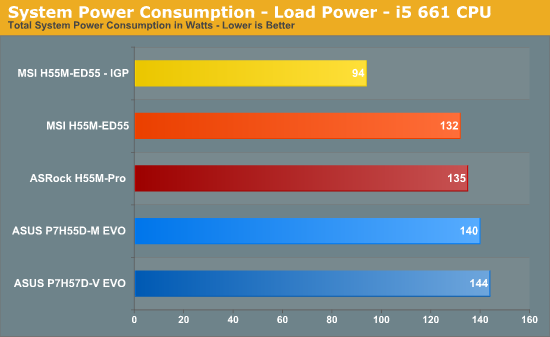Choosing the Best H55/H57 Motherboard - Part 1
by Rajinder Gill on January 31, 2010 11:30 PM EST- Posted in
- Motherboards
Testbed Setup and Power
| Testbed Setup - Overclocking / Benchmark | |
| Processor | Intel Core i5 661 ES CPU - 3.33GHz - 2 Cores 4 Threads, 4MB Cache |
| CPU Voltage | Various |
| Cooling | Intel air cooler Heatkiller 3.0 waterblock PA120.2 radiator and DDC ultra pump (with Petra top) 1/2 ID tubing for watercooling |
| Power Supply | Corsair HX950 |
| Memory | Corsair Dominator CMD8GX3M4A1600C8 1600MHz 8GB kit G.Skill Perfect Storm 8-8-8-24 2200MHz 4GB kit Corsair Dominator GT 8-8-8-24 2200MHz 4GB kit (X2 for 8GB) |
| Memory Settings | Various |
| Video Cards | MSI 275 Lightning (stock clocks) |
| Video Drivers | nVidia 195.62 WHQL |
| Hard Drive | Western Digital 7200RPM 1TB SATA 3/Gbps 32MB Buffer OCZ Vertex 120GB SSD |
| Optical Drives | Plextor PX-B900A Toshiba SD-H802A |
| Case | Open Test Bed - Dimastech Benching Station Lian-Li V2110 |
| Operating System | Windows 7 64 bit |
| . | |
We utilized memory kits from Corsair and G.Skill to verify memory compatibility on our test boards. Our OS and primary applications are loaded on the OCZ Vertex 120GB SSD drive and our games operate off the WD Caviar Black 1TB drive. We did a clean install of the OS and applications for each motherboard.
We used Intel's stock cooler for the stock comparison testing, while water-cooling via the superlative Heat Killer 3.0 water block was utilized for overclocking. For graphics duty, we used MSI's GTX 275 Lighting GPU to provide performance comparisons between boards during gaming benchmarks.
For our test results we set up each board as closely as possible in regards to memory timings. Otherwise all other settings are left on auto. The P55 utilized 8GB of DDR3 (apart from DFI's MI-T36 which is limited to 4GB), while the X58 platform contained 6GB. The P55 and X58 DDR3 timings were set to 7-7-7-20 1T at DDR3-1600 for the i7-920 and i7-870 processors at both stock and overclocked CPU settings.
We used DDR3-1333 6-6-6-18 1T timings for the i5-750 stock setup for all system benchmarks (non-gaming tests) as DDR3-1600 is not natively supported at a stock BCLK setting of 133.
For our Clarkdale i5 661 CPU, we used 7-7-7-20 1N timings at DDR3-1333MHz with 8GB of memory. We would have preferred to use CAS 6 timings to match our Lynnfield setup, but it seems 8GB of memory at CAS 6 on Clarkdale is not possible right now. The 4GHz gaming results used 8GB of memory at DDR3-1200 with CAS 6-6-6-18 1N timings to allow a BCLK of 200MHz with the QPI ratio in sync with CPU frequency.
There's little to separate these boards when you run them at a fixed frequency, showing nothing more than a 1-2% swing in most instances, which goes completely unnoticed in real world usage.
Power consumption
Our power consumption testing utilizes the same batch of components under similar circumstances in a bid to monitor variances between idle and CPU load conditions using an AC wall meter for power consumption measurements. We install the vendor supplied power saving utilitites on each board and enable power saving modes that don't involve any kind of underclocking or CPU core frequency modulation in order to run an apples to apples comparison.
Assuming a maximum 150w load in the worst case scenario, actual motherboard power consumption is around 15%~17% lower than the shown figures if you factor out switching losses at the PSU.


MSI continues in its dominance of idle/light load power saving performance by using buck controllers that support low switching speeds and allow phases to be turned off in light load conditions.
A graphics card like nVidia's 275 will add around 28w of idle power consumption to a Clarkdale system. It is unfortunate that Intel (and board vendors) do not offer drivers/GPU power management that allow a discrete GPU to be powered on/off on demand - the power savings would be rather attractive.
Note that most of the CPU VCC power saving features on these boards need to be turned off when overclocking to ensure system stability and to prevent PWM burnouts under modulating loads at higher levels of current draw. With power saving features switched off, you get a 5~10W increase in the idle power consumption at the same operating frequency, while load power consumption remains roughly the same due to current loading.










56 Comments
View All Comments
Rajinder Gill - Monday, February 1, 2010 - link
Hi AG,I think Anand touched on some AMD/Intel compares in his Clarkdale articles. Have a look at these and see if they offer some of what you are looking for;
http://www.anandtech.com/cpuchipsets/showdoc.aspx?...">http://www.anandtech.com/cpuchipsets/showdoc.aspx?...
http://www.anandtech.com/cpuchipsets/showdoc.aspx?...">http://www.anandtech.com/cpuchipsets/showdoc.aspx?...
regards
Raja
Rajinder Gill - Tuesday, February 2, 2010 - link
Forgot to mention, check out the Anandtech bench beta for CPU performance compares:http://www.anandtech.com/bench/default.aspx?b=2">http://www.anandtech.com/bench/default.aspx?b=2
regards
Raja
JonnyDough - Thursday, February 11, 2010 - link
Will there be a graphics chart beta soon too? Please say yes. :)Rajinder Gill - Thursday, February 11, 2010 - link
Hi JD,Can't give you a time frame on it yet unfortunately, but yes, we will be adding GPU's at some point..
regards
Raja
JonnyDough - Friday, February 12, 2010 - link
That's fantastic news, there are other sites I just don't trust to do it right. :)I'm sure you'll be deliberating what test beds to use, and so on. We really need to see both dual and quad core, with at least a couple of older processors (939 athlons?) thrown in for reference. Or let us know the best card that those platforms can realistically support as many of us still use these PCs for gaming.
Many basic users fail to understand resolution and their game settings. It can be tough to know just what your card is designed to do within any certain application. For instance, some cards run higher frame rates than others with AA turned off, but then with it turned on they the cards will switch. What would be nice is to see a chart that shows checkmarks and X's for "above X-fps" for games. Allow me to better describe what I mean:
I don't honestly care if a card does 60 vs 65 fps in Fallout 3, just whether or not it can play Fallout 3 with max settings, and also play Bioshock 2 at max settings.
Rather than tell me what FPS a card gets, just simplify by showing ranges. If my card can't get "above 30fps" put an X for that game on the table. If a game isn't playable below 45FPS, then you won't need to list it for any cards unable to do that many. Above 40fps for the next box, and so on.
This sort of testing might not only make it easier to create your tables, but be more useful to shoppers. I don't need to know if a 5770 can do 120FPS in WoW because quite honestly, it doesn't matter if it can only do 60. I just want to know, can it play it with the eye candy on, or not?
deputc26 - Monday, February 1, 2010 - link
You run a tight ship Anand! :)